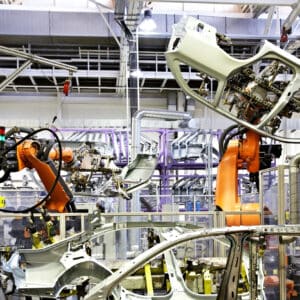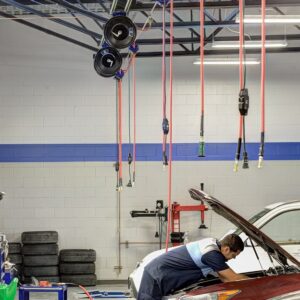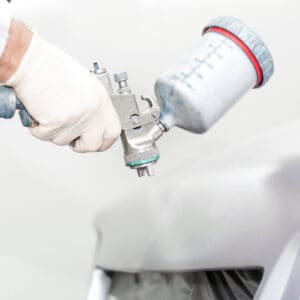Just as cars and trucks are part of most of our daily lives, compressed air is vital in the automotive industry’s day-to-day operations, ranging from vehicle assembly to engine construction, painting, and cleaning. A more obvious use includes the auto tyre business.
Below, we’ll look at some typical automotive industry uses for compressed air.
AIR-OPERATED ROBOTS
The automotive industry without robotics is unthinkable today. Robots assist in the press shop with clamping and induction. They are also integral to automotive production in other processes, such as painting, welding, and assembly.

AIR TOOLS
Compressed air tools are chosen for many tasks when constructing larger components, including fastening bolts and screws with air-powered wrenches. Air ratchets can also be used to remove nuts and bolts, while an air-powered saw will carry out cutting and grinding operations.

PAINT SHOP WORK
Manufacturers, body shops and garages use low-pressure compressed air to propel paint through spray guns onto the surface of the car body. Compressed air is also used in a paint bath to agitate the contents and prevent paint clumping. In addition, this helps to mix the colour so it’s perfectly consistent.

TYRE FITTING
Tyre fitters use compressed air tools to remove wheel nuts and screw them up again after the tyre is replaced. Compressed air is, of course, the means of inflating the tyre, which can also be done at most garages.

What To Consider When Using Compressed Air
CONTAMINANT-FREE AIR
To ensure the smooth running of a compressed air system, the air supply must always be perfectly clean and dry, especially when applying spray paint and finishes.
- Solid particulates, such as rust, can clog up spray gun nozzles and produce an imperfect finish.
- Oil in the air supply can cause paint to flake, crack or bead. It can also prevent paint from adhering properly to the surfaces, affecting the final finish and providing the potential for future corrosion.
- Water particles in the air supply are equally, if not more damaging, blocking the compressed air’s path and sticking to the walls of pipes.
- Moisture can get pulled back into the system, collecting in the receiver or at low points in the pipework, then squirting unexpectedly from a paint nozzle.
Contamination can damage downstream pneumatic equipment, leading to expensive production downtime and costly replacement of damaged equipment. To reduce the contaminants in a compressed air system, it’s essential to ensure the compressed air is properly prepared for use. This means installing and maintaining a filter, regulator and lubricator system, or FRL unit. This cleans the air, regulates the pressure and adds a necessary amount of lubricant to the final air supply so that actuators and power tools run smoothly.
A compressed air dryer may also be employed when using spray guns, with coalescing filters to make sure any naturally occurring moisture is removed.
If you’re looking to invest in compressed air systems for auto body work or for manufacturing, you should contact us at 1300 272 982. The technology that powers the world is always evolving; don’t let your compressed air system fall behind.

